Você já tentou fazer upload de um arquivo para o seu site WordPress e se deparou com um obstáculo? É muito frustrante quando você não consegue carregar a imagem, o plug-in ou o tema de que precisa. Nossos leitores frequentemente nos pedem ajuda com problemas de upload de arquivos, pois eles podem atrapalhar seu fluxo de trabalho.
Às vezes, esses limites de upload de arquivos podem impedi-lo inesperadamente de adicionar conteúdo à sua biblioteca de mídia ou de instalar os plug-ins e temas maiores de que você precisa. É como estar de mãos atadas. E é ainda mais irritante quando você não sabe como resolver isso!
Mas não se preocupe, estamos aqui para ajudar. Adoramos o fato de o WordPress ser uma plataforma tão configurável, e muitas vezes há várias maneiras de resolver o mesmo problema.
Neste guia, mostraremos a você as maneiras mais fáceis de aumentar o tamanho máximo de upload de arquivos no WordPress. Vamos ajudá-lo a superar essas limitações para que você possa voltar a fazer o que gosta: administrar seu site!
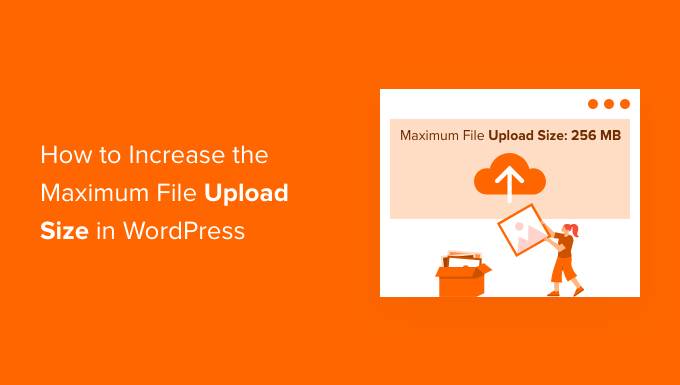
Por que aumentar o tamanho máximo de upload de arquivos no WordPress?
Seu provedor de hospedagem WordPress definirá um tamanho máximo de upload de arquivo padrão quando você se inscrever e instalar o WordPress. Seu provedor de hospedagem define esse limite, que geralmente varia de 2 MB a 500 MB.
Para a maioria dos proprietários de sites WordPress, esse limite será mais do que suficiente.
No entanto, há ocasiões em que você precisará aumentar esse limite para não ter erros de upload.
Por exemplo:
- Você administra um site de fotografia e precisa fazer upload de imagens grandes.
- Seu portfólio de design ou fotografia tem imagens grandes.
- Você deseja instalar um tema ou plug-in maior do WordPress.
- Você deseja vender produtos digitais, como livros eletrônicos, fotos, vídeos e muito mais.
- Você atualiza regularmente o conteúdo e adiciona áudio, fotos e outros itens que estão além do limite atual.
Dito isso, vamos mostrar como você pode aumentar o tamanho máximo de upload de arquivos em seu site WordPress.
Observação: lembre-se de que a exibição de muitos arquivos grandes em seu site pode reduzir seriamente a velocidade e o desempenho dele. É por isso que normalmente recomendamos nunca fazer upload de vídeos para o WordPress.
Como a maioria dos usuários tem diferentes configurações de hospedagem do WordPress, abordaremos o seguinte:
- How to Check Your Maximum File Upload Size Limit in WordPress
- Method 1: Contact Your WordPress Hosting Provider
- Method 2: Create or Edit an Existing php.ini file
- Method 3: Add Code to Your WordPress Theme functions.php File
- Method 4: Add Code to Your .htaccess File
- Method 5: Use a WordPress Plugin to Increase File Upload Size
Como verificar o limite máximo de tamanho de upload de arquivos no WordPress
O WordPress mostrará automaticamente o limite máximo de tamanho de upload de arquivos quando você estiver fazendo upload de imagens ou outras mídias.
Para verificar isso, basta ir para Mídia ” Adicionar novo no painel de administração do WordPress e você verá o limite máximo de tamanho de upload de arquivo para o seu site WordPress.
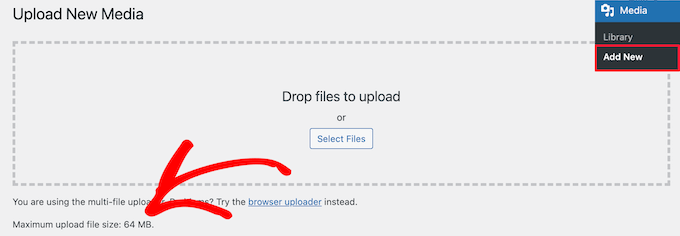
Agora que você sabe como encontrar o limite de tamanho, vamos mostrar como aumentar o tamanho máximo de upload no WordPress.
Método 1: Entre em contato com o provedor de hospedagem do WordPress
Uma das maneiras mais fáceis de aumentar o tamanho máximo de upload de arquivos no WordPress é entrar em contato com o provedor de hospedagem do WordPress.
Essa é uma tarefa relativamente simples para a equipe de atendimento ao cliente e pode ser feita em alguns minutos.
Para iniciantes, isso pode ser muito mais fácil do que adicionar código ao WordPress e editar arquivos do servidor.
Basta acessar o site do seu provedor de hospedagem, como a Bluehost, e fazer login.
Em seguida, clique no ícone “Chat” na parte inferior da tela. Em seguida, você pode solicitar à equipe de suporte que aumente o tamanho do upload de arquivos em seu site do WordPress.
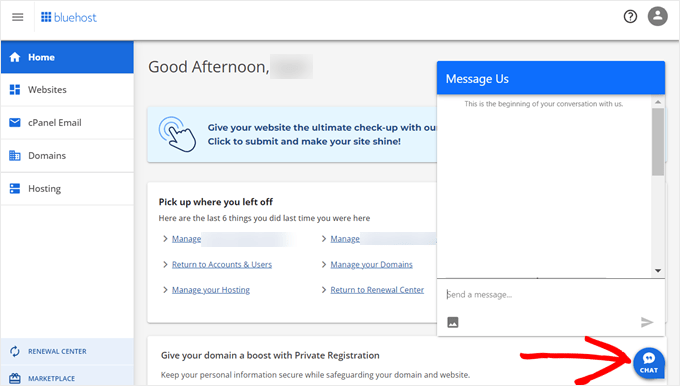
Você também pode entrar em contato com o suporte no painel da sua conta de hospedagem.
Método 2: Criar ou editar um arquivo php.ini existente
Outra maneira de aumentar o tamanho máximo de upload de arquivos é criar ou editar um arquivo chamado php.ini. Esse arquivo controla várias configurações do seu ambiente de hospedagem do WordPress.
A maioria dos provedores de hospedagem WordPress, como a Bluehost, tem um cPanel amigável para iniciantes para ajudar a gerenciar seu site.
Se o seu host da Web tiver um painel cPanel, você poderá aumentar o tamanho do upload de arquivos por meio das ferramentas integradas.
Observação: o texto a seguir foi extraído do cPanel da Bluehost. No entanto, a maioria dos provedores de hospedagem compartilhada terá etapas semelhantes.
Você encontrará um botão do cPanel na parte inferior da guia Hosting na Bluehost.
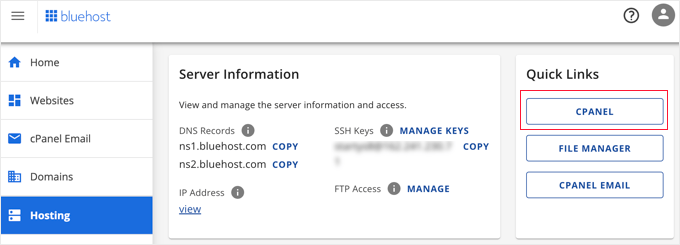
Clicar nesse botão abrirá o painel do cPanel.
Agora você precisa rolar para baixo até a seção Software e clicar em ‘MultiPHP INI Editor’.
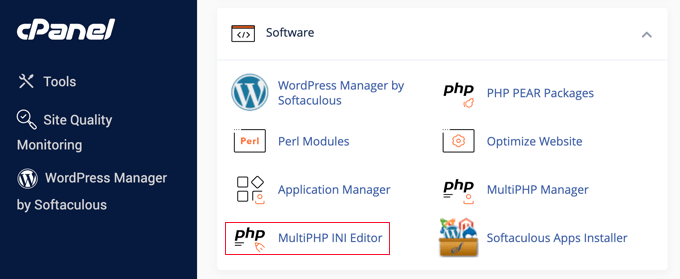
Em seguida, role para baixo até a seção denominada ‘upload_max_filesize’ e insira um novo tamanho máximo de arquivo na caixa.
Em seguida, clique no botão “Apply” (Aplicar).
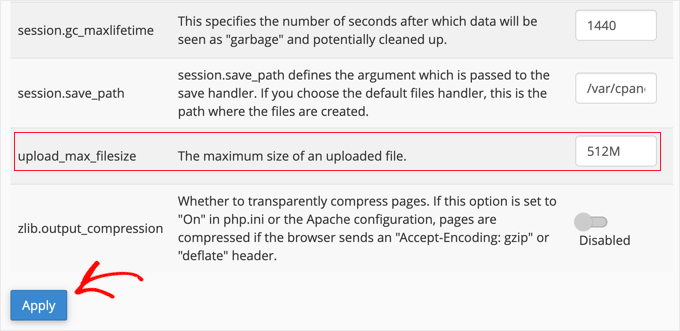
Como alternativa, você pode clicar na guia do menu “Editor Mode” e alterar o tamanho máximo de upload de arquivos diretamente no editor.
É necessário editar a seção “upload_max_filesize” para aumentar o tamanho do upload do arquivo.
Quando terminar, basta clicar no botão “Salvar”.
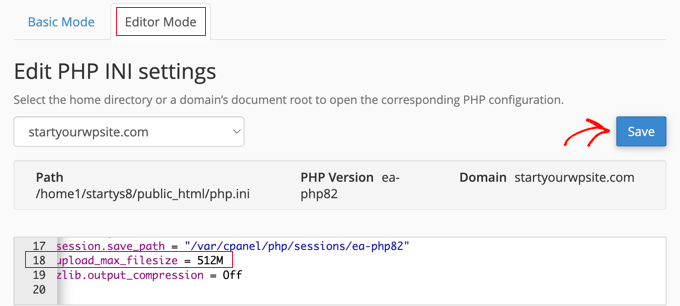
Editar o php.ini adicionando código
Se o seu provedor de hospedagem atual não oferecer a opção cPanel, você precisará editar esse arquivo manualmente.
Para isso, você pode usar um cliente FTP ou a opção de gerenciador de arquivos no painel de controle da hospedagem do WordPress.
Se você estiver usando hospedagem compartilhada, talvez não veja o arquivo php.ini no diretório de hospedagem. Se não encontrar um, basta criar um arquivo chamado php.ini e carregá-lo em sua pasta raiz.
Em seguida, adicione o seguinte trecho de código ao arquivo:
1 2 3 | upload_max_filesize = 256Mpost_max_size = 256Mmax_execution_time = 300 |
Você pode modificar o limite de “256M” para o tamanho de arquivo necessário para o seu blog do WordPress.
Método 3: Adicionar código ao arquivo functions.php do tema do WordPress
Esse método envolve a adição de código ao arquivo functions.php em seu tema do WordPress.
Em vez de editar o arquivo diretamente, recomendamos o uso do WPCode. É o melhor plug-in de snippets de código que permite adicionar código ao seu site sem quebrá-lo.
Se você nunca fez isso antes, consulte nosso guia para iniciantes sobre como adicionar código personalizado no WordPress.
Primeiro, você precisa instalar o plug-in gratuito WPCode. Para obter mais detalhes, consulte nosso guia passo a passo sobre como instalar um plug-in do WordPress.
Após a ativação, você deve navegar até Code Snippets ” + Add Snippet.
Você precisará passar o mouse sobre a opção “Add Your Custom Code (New Snippet)” e, em seguida, clicar no botão “+ Add Custom Snippet”.

Em seguida, você precisa escolher “PHP Snippet” como o tipo de código na lista de opções que aparece.

Na tela seguinte, digite um nome para o novo snippet, que pode ser qualquer coisa que o ajude a lembrar para que serve o código.
Em seguida, você pode copiar e colar o seguinte trecho de código em “Code Preview” (Visualização de código). Certifique-se de alterar “256M” para o tamanho máximo de arquivo que você precisa:
1 2 3 | @ini_set( 'upload_max_size' , '256M' );@ini_set( 'post_max_size', '256M');@ini_set( 'max_execution_time', '300' ); |
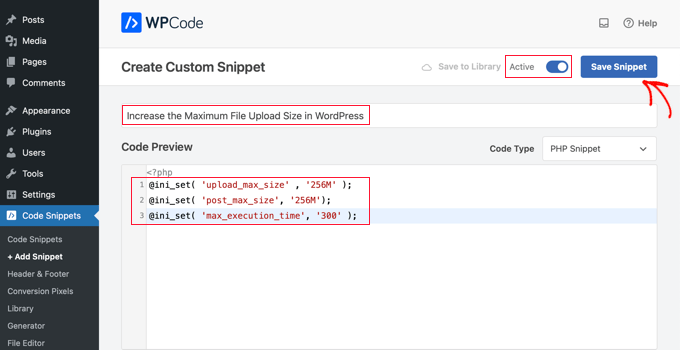
Por fim, alterne a alternância na parte superior para “Active” (Ativo) e, em seguida, clique no botão “Save Snippet” (Salvar snippet). O código agora será executado em seu site.
Método 4: Adicionar código ao seu arquivo .htaccess
Outra maneira de aumentar o tamanho máximo do arquivo é modificar o arquivo .htaccess. Esse arquivo controla as definições de configuração de alto nível do seu site.
Para fazer isso, é necessário fazer login no servidor do site via FTP. Se você nunca fez isso antes, consulte nosso guia sobre como usar o FTP para fazer upload de arquivos no WordPress para iniciantes.
Depois disso, você precisa localizar o arquivo .htaccess na pasta raiz do seu site.

Se você não conseguir encontrar o arquivo .htaccess, ele pode estar oculto pelo gerenciador de arquivos ou pelo cliente FTP. Para saber mais, consulte nosso guia sobre por que você não consegue encontrar o arquivo .htaccess em seu site WordPress.
Em seguida, você precisa adicionar o seguinte trecho de código ao seu arquivo .htaccess:
1 2 3 4 | php_value upload_max_filesize 256Mphp_value post_max_size 256Mphp_value max_execution_time 300php_value max_input_time 300 |
Para aumentar ainda mais o tamanho máximo de upload de arquivos, basta alterar o valor “64M” para o tamanho desejado.
Método 5: Use um plug-in do WordPress para aumentar o tamanho do upload de arquivos
Outra maneira de aumentar o limite máximo de upload de arquivos é usar o plug-in WP Increase Upload Filesize. Se você não se sente à vontade para adicionar código ao WordPress, essa pode ser uma boa opção para você.
A primeira coisa que você precisa fazer é instalar e ativar o plug-in. Para obter mais detalhes, consulte nosso guia sobre como instalar um plug-in do WordPress.
Após a ativação, navegue até Mídia ” Aumentar limite de upload no painel de administração do WordPress.
Isso o leva a uma tela em que você pode selecionar um novo tamanho de upload de arquivo no menu suspenso ‘Choose Maximum Upload File Size’.
Em seguida, clique no botão “Save Changes” (Salvar alterações).

Observação: o tamanho máximo de upload de arquivos será definido pelo seu provedor de hospedagem. Se precisar de um limite de tamanho de arquivo maior do que o listado no menu suspenso, será necessário entrar em contato com o provedor de hospedagem e solicitar o aumento do limite.
Tutorial em vídeo
Se você não gosta de seguir instruções escritas, pode conferir nosso tutorial em vídeo:
Esperamos que este artigo tenha ajudado você a aumentar o tamanho máximo de upload de arquivos no WordPress. Talvez você também queira ver nosso guia sobre como adicionar tipos de arquivos adicionais para upload no WordPress e nossas escolhas de especialistas de plugins e dicas para melhorar a área de administração do WordPress.
Se você gostou deste artigo, inscreva-se em nosso canal do YouTube para receber tutoriais em vídeo sobre o WordPress. Você também pode nos encontrar no Twitter e no Facebook.





Manish
I am unable to import my blogger exported xml file to wordpress.
My blogger imported xml file size is 24 mb.
Please solve this problem, i shall be thankful to you.
Hashim
3. htaccess Method worked for me.
Thanks
John
Has anyone ever told you that the copy and paste YOUR code all throughout your site always has the:
1: code
2: code
3: code
So it’s a bit of a edit to get it to work right when a simple copy/paste would be stressfree for your readers! Just sayin…
John Delaney
Create php.ini file and place it in wp-admin folder, not the root. Fixes it every time.
Michael Kelley
Thanks! This is the only thing that worked for me. Worth noting, I already had a php5.ini file in there w/ the same code, it did nothing. A tad confusing.
Mudassar
htaccess worked
Robert
After 2 hours of frustration, the htaccess method mentioned here worked out for my local environment.
Thank you very much.
Robin
I change my .htaccess and put
php_value memory_limit 2G
php_value upload_max_filesize 2G
php_value post_max_size 2G
php_value max_execution_time 99999
php_value max_input_time 99999
when I go for upload a fine it shows 2GB but when I upload any file that larger then 128MB it shows HTTP error. Need help please.
Thanks
Zain Zaheer
Set max limit to 128M instead of 2G
Robin
I add on my .htaccess
php_value memory_limit 2G
php_value upload_max_filesize 2G
php_value post_max_size 2G
php_value max_execution_time 99999
php_value max_input_time 99999
and it shows 2GB but when I upload larger then 128M file it gives me HTTP error. can anyone help me please.
Thanks
Elisabeth Parker
I DO NOT recommend putting that code in the Theme Functions file. I tried it and it completely blew up my site. And if you don’t know how to use FTP or the File manager to change the Functions file BACK, you’ll be very unhappy. I haven’t tried the other options but if I find something that works I’ll let you know
kennedy Odhiambo
Hello Elisabeth,ive tried it and it has also blown up my site,i cant acces it…may i please know how you fixed it?
Caki
Just contacted godaddy. I am using cpanel hosting through them. He added a file .user.ini in the public/html file with the following:
memory_limit = 128M
max_execution_time = 300
post_max_size = 128M
upload_max_filesize = 256M
razib ahmed
thank you so much! it,s working for me
Tino
I’m with Axxess and this also worked for me!
Mukhiiii
You made my day!
Thanks
Paul Vijay
Thanks a lots this Worked for me . I too use Godaddy Hosting, Still the Template fails to load from Online database can u help
Bob
do you name it .user.ini or user.ini ??
Jesse
This method worked for me! Thank you so much for sharing!!!
Craig
in the .htaccess solution, where in the file do you enter the code, i put it at the end and got a 500 error?
Cornelius
I heard as an alternative you could just directly upload via the ftp cpanel, but when I do that the PDF does not show up in my WP media dashboard?
WPBeginner Support
Hi Cornelius,
You can upload a PDF file but yes you are right it will not be visible in the Media library on your WordPress site. To see a file in the media library and be able to easily add it, you would need to upload it using the built in media uploader.
Admin
Christopher Eller
You can upload anything via FTP/SFTP and then add it to the database using a plugin like Add From Server.
Nitus
This worked for me (as nothing else would):
– Open wp-config.php
– At the very bottom add this line:
define(‘WP_MEMORY_LIMIT’, ‘128M’);
– Save (and upload your file)
Maja
So i’m not a developer so i dont feel like messing with php and some functional stuff.
i found from a post above php settings and all is set right, max file size is 30MB so i’m confused why i still can’t upload media bigger than 5mb.
is there a wordpress thing that i’m missing
i didn’t find anywhere place to change that,
Niall Flynn
If you are using cPanel most of the time you edit via the PHP Version settings, you can check if you are on 5.6 or 7.0 and edit all the settings via cpanel. For me this is the only way my host has all the others locked down, but its real handy and there are simple ways to enable PHP modules and tweak any setting.
yaser
Thanks.
This is what finally worked for me:
In wp-config, before wp-settings:
define( ‘WP_MEMORY_LIMIT’, ‘256M’ );
define( ‘WP_MAX_MEMORY_LIMIT’, ‘256M’ );
ini_set( ‘memory_limit’, ‘256M’ );
In .htaccess:
php_value memory_limit 256M
php_value upload_max_filesize 64M
php_value post_max_size 64M
php_value max_execution_time 300
php_value max_input_time 300
mohammad
thanks man you made my day it worked
Evan Olsen
This worked for me! Thank you!
Rudrax
Thanks Friend It Worked!
Yna Capumpue
How do you get to the wp-config? I mean where do you input the code itself? Thanks.
maneesh naithani
made my day. thank you man.
Rahadian
Thank you for this valuable post, .htaccess method works for me
Abhishek
Thanx a lot php.ini option works thanx a lot
Sean
Hello
I am building a woocommerce store for selling audio files. Some of my files are over 100MB so uploading straight from wordpress wont work. What I am trying to do is Upload the file to cpanel and than post that link in the downloadable product on WP. But I dont know how to do it. I view the file in cpanel and copy that link but that just takes the person to cpanel login. I dont know hot to get the link of my file in cpanel so others can download it when they buy a product?
Do you have a tutorial on this?
or can you help?
Thanks
Ian
You would need to look more into this because you would need security for that file url, generally the file url is accessible to everything and therefore can be downloaded without making a purchase.
Larry Scott
The second suggestion of creating a php.ini file works like a charm.
john
Absolutely DO NOT try to enter that code into the Theme Functions file!!!!! Now I am getting error messages and can’t get to the dashboard for my site. I won’t DARE try any of their other suggestions.
WPBeginner Support
Hi John,
You can easily edit your functions.php file using an FTP client to undo the changes you made.
Admin
Fred Preston
Thanks. the .htaccess version worked for me. I just had to remember to show hidden files in my cpanel file manager.
John
Just wanted to say thanks. I’ve been able to solve three wordpress related issues in one day, all with help from this website. Kudos on the good work.
WPBeginner Support
Thanks John Don’t forget to join us on Twitter for more WordPress tips and tutorials.
Don’t forget to join us on Twitter for more WordPress tips and tutorials.
Admin
Shameer
Very HelpFull
David
Thanks.
The php.ini edits helped. I had to make sure to also up the post_max size as well. I failed to edit this on first update, and nothing changed. Edit all parameters and presto. Thanks again!
Alyse
Is there a specific place to add it in the theme functions file? The beginning? The end?
Shambo
Modifying .htaccess file worked for me. Thanks a lot..
Celal Erdogdu
It works, thank you.
WPBeginner Support
You are welcome
Admin
Bentham
Thank you so much ,option one gave me a hint
Mohsin
.htaccess method worked for me. Thanks for this article.
Aswani Somarajan
It was great. Very helpful! Had to upload a theme, used the second method. added a ner php.ini file and the theme is installed. Thanks a lot
John
Thanks for helping
making the changes in the .htaccess method made the website crash
however changing the php.ini file worked for me.
Don
or try another method like mine,
on cpanel > click the “select php version” > then click “switch to php options” > find the “upload_max_filesize” then change it whatever you want.
Aoun
Thanks…… Its very helpful and working perfectly
Jose
Thnxs dude, you saved my job
Md Robiul Islam
Thanks you so much… for your comment I fix my issue after try long time.. thanks a lot…..
Miaka
The methods in the article didnt work for me but this did! Thank you so so much, Don! Article author, hope you could edit this method as one of the solutions in your article!
DAVID
@DON Thank you!
Rudi
Thank you so much, I used the htaccess Method and it’s worked for me.
bob hildegard
‘upload_max_size’ is not a php.ini variable name. it’s ‘upload_max_filesize’. that’s stated wrong in solution 1
Eric
First thing I tried was modifying the .htaccess file. Worked for me!
sumit
thanks a ton , u saved me
Reza
htaccess option returns a 500 Internal Server error when reloading my website and wp admin
kashyapkumbhani
sir i Tried all But my Xml File Not Imported Please Help me:) thank u
Trevor
I tried your first suggestion, and apparently threw some bad code into the functions.php file and now I have lost access to my website’s dashboard, the actual website cannot be accessed by anyone, and the problem is obviously not solved.
WPBeginner Support
Please see our guide on what to do when you are locked out of the admin area.
Admin
Aakarshit
None of then worked ; (
Even contacted the hosting provider, no reply from them ; (
frizzy lee
thanks .. the htacess method worked for me too .. thumbs up bro
Okie Wardoyo
Hi, where i should put that code to my .htaccess file.
I have tried put this code to my htaccess file but it always 500 internal server error when i open my live site.
# BEGIN WordPress
RewriteEngine On
RewriteBase /
RewriteRule ^index\.php$ – [L]
RewriteCond %{REQUEST_FILENAME} !-f
RewriteCond %{REQUEST_FILENAME} !-d
RewriteRule . /index.php [L]
php_value max_input_vars 5000
php_value max_execution_time 300
php_value post_max_size 50M
# END WordPress
John Jones
Try this:
php_value upload_max_filesize 50M
php_value post_max_size 50M
php_value max_execution_time 300
php_value max_input_time 300
Jitender Singh
.htaccess works nicely.
subodeep ray
thanks .htaccess works smoothly
Bukunmi
Where exactly do I put those codes in my Theme function? because i’m kind of lost
Galuh Prasetyawan
in Appearance -> editor, find function.php
Eóin Kilroy
Right, but where exactly in the function file?
Manas Mitra
Hi,
I have used the first method of adding code to child theme functions.php file, but it does not have the desired effect. In localhost, the limit is 3 MB and in shared server, the limit is 32 MB. Any idea why it is happening so?
Thanks.
Bouguezzi
the .htaccess modification methode worked with me thx a lot
thx a lot
WPBeginner Support
Glad you found it useful. Make sure you follow us Facebook to get more WordPress tips.
Admin
cathy belyea
i have followed this even contacted my host increased my uploads to 64mb however in wordpress it still only allows 8mb.
any other suggestions please help.
Guillermo
Same problem for wordpress 3.9 / 4 version and having a look to Chrome console or firefox I saw an error 413 of NGINX when uploading
Maybe this thread can help to nginx users